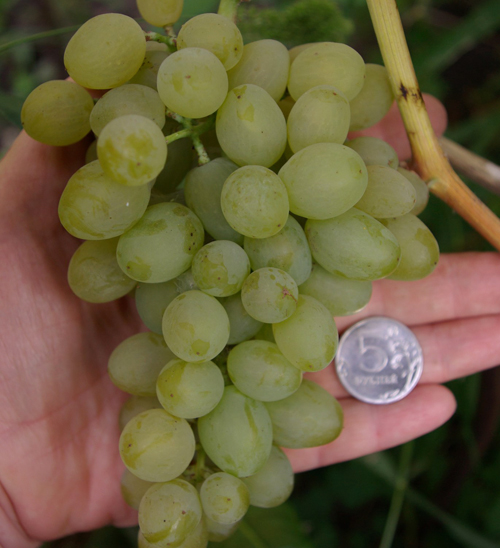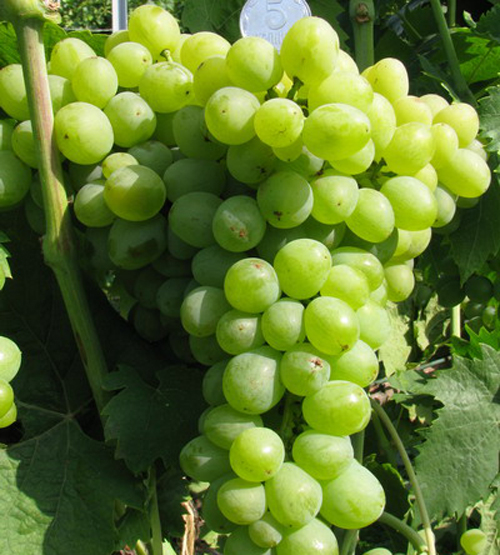Grape variety Elegant
The elegant, which is most often understood as the very early Elegant, is a popular hybrid form of table grapes, developed at the end of the last century at the All-Russian Research Institute of Viticulture and Winemaking named after V.I. ME AND. Potapenko by a team of scientists led by the famous Russian breeder Ivan Kostrikin. The variety also has a twin brother, which is functionally feminine in bloom, but is also called Elegant. It is very poorly distributed, but sometimes it is found, which is why it introduces confusion among winegrowers.

To obtain the superearly Elegance, the same parental pair of varieties was used, from which such magnificent varieties were born as Kesha, Timur, Tamerlane. In particular, the Moldovan Frumoasa Albă served as the maternal form, and the unsurpassed domestic Delight... At the same time, unlike his illustrious "brothers", our hero did not have a chance to pass the state variety testing, and therefore his name does not appear in the register of zoned varieties. However, this formality did not prevent him from gaining many admirers among amateur winegrowers, who sincerely appreciate him for his very early ripening, unpretentiousness and plasticity, and, of course, decent taste and pleasant nutmeg aroma of berries. Sophisticated experts consider the disadvantages to be insufficiently attractive, due to the greenish color of the berries, a bunch, as well as a certain tendency of grapes to pea when it comes to a variety with a female type of flower.
At the same time, despite the fact that over the past years the assortment of varieties has been replenished with a huge number of the latest hybrid forms, including those outstanding in their aesthetic qualities, our hero is clearly not going to disappear into oblivion. Regular rave reviews about him only confirm this.
Agrobiological characteristics
Plants do not differ in great vigor and size. Leaves grow large, mostly rounded, dark green, three- or five-lobed with an average degree of dissection. Their upper lateral notches are quite deep, most often open with parallel sides and a rounded bottom, some are closed with an ovoid lumen. The lower notches are very small, V-shaped, or barely outlined. The surface of the leaf blade is coarsely bubbly, the profile is flat with the edges of the blades bent downward. The petiole notch is open, lyre-shaped, with a sharp bottom. Petioles are long, thin, pale green in color. The denticles along the edges of the grape leaf are unequal in size, triangular with a narrow base, straight edges and pointed tops. The flowers of the Elegance are very early bisexual, have an excellent ability to pollinate even in unfavorable conditions for flowering. Shedding of inflorescences and ovaries is not observed. The variety does not have peas. The usual Elegant, as already mentioned, is distinguished by unisexual flowers, which is why the peas of its berries are quite frequent. Annual growth in plants is on time and ripens well. At the same time, the shoots change their color to yellowish brown.

The size of the bunches can vary widely, depending on the load of the bushes and the growing conditions. Their mass ranges from 300 to 600 grams, the most outstanding can reach a kilogram. The combs are short and of medium length, herbaceous. The shape of the grape clusters is cylindro-conical, the structure is moderately loose. Due to the free arrangement of the berries, they are not squeezed or deformed, and thanks to their uniform size, the bunches look neat and attractive. The grapes are rather large, oval or nipple-shaped, grow up to 30 mm in length and 19-21 mm in diameter. Their color, even when ripe, is greenish-white, complemented by a light waxy bloom on the surface. The fruits of the Elegance with FZHTC look a little better.Although its berries cannot boast of exceptional evenness, they acquire an amber tan in the sun. The average weight of grapes is 5-7 grams. The pulp is moderately dense, juicy-fleshy, very sweet with a delicate aroma of nutmeg in the aftertaste. As a direct descendant of Rapture, the cultivar has inherited excellent sugar accumulation. This indicator in berry juice is 19-22 g / cubic cm, with a titratable acidity level of 6-8 g / cubic dm. The peel of the berries is rather thin, but strong, and it is very easy to chew. Small seeds, 1−2 in the berry, do not spoil the evaluation at all during tasting.
As a table grape, the variety is intended primarily for fresh consumption. Many farmers, tempted by the unpretentiousness of our hero, are actively cultivating it for commercial purposes, but they complain that the greenish color of the hybrid berries does not add to its attractiveness in the eyes of the buyer. However, this problem is compensated by the early arrival of the crop on the market, at a time when the competition is not so great, and therefore it does not stay on the shelves for a long time. The worries about the lack of ripeness of grapes are especially quickly dispelled when customers taste the berries and feel their remarkably sweet and aromatic taste. After tasting, a less expressive appearance usually fades into the background. An additional advantage expanding the possibilities for the realization of the variety is the excellent transportability of its bunches. During transportation over long distances, they retain their original condition, do not crumple or crumble.

It is not in vain that Elegance is called the supremely early one, because its growing season from the mass budding to the ripening of the first bunches lasts only 100-110 days, and the harvest in the south begins already from the end of July. A little longer, for 5-10 days, the form with the female type of flowers ripens, but it also belongs to the early varieties of grapes. The sum of active temperatures required for plants ranges from 2200 to 2400 ° C, which speaks volumes about the possibility of their cultivation much to the north of the traditional regions of viticulture. Even a number of areas of the Non-Black Earth Zone of our country are quite suitable for our hero in order to annually please their owners here with a magnificent, fully ripe harvest. The frost resistance of the vine is of particular importance in the harsh cultivation conditions. And in this respect, the hybrid shows itself from a very worthy side. Being able to withstand the winter cold at -25 ° C without damage, it feels great in the south without any insulation, and in the middle lane it only needs a light earthen or film shelter.
The variety quickly begins to bear fruit, especially those bushes that are planted with own-rooted cuttings. The productivity of the Elegance is quite high, and, in addition to the large size of the bunches, it is provided by an excellent percentage of fruitful shoots - 75-95%, a high fruiting rate - 1.3-1.7 and a fruitfulness - 1.6-2. These parameters mean that on almost every developed vine shoot, more than one brush is laid, and often not too powerful bushes are unable to pull out such a load without negative consequences for themselves. As a result of overloading, one can observe an even greater deterioration in the vigor of shoot growth, smaller bunches, a decrease in the palatability of fruits and an extension of their ripening period. In order to prevent this, it is necessary to carry out annual yields rationing, taking into account many factors, from the age of the plants to the conditions of their cultivation and care.
After ripening, the bunches can remain hanging on the vine for a very long time, without losing their presentation, without decaying and without reducing the taste.The variety is not at all prone to cracking of berries, and in this regard, neither torrential rains nor a sharp change in soil moisture as a result of watering are afraid of it. Grapes do not lose their firmness in arid conditions, where many other varieties would start to grow. And even wasps, which are the scourge of table viticulture, show no interest in our hero.
Agrotechnical features
The economic characteristics of the Elegance are its strong point, which determines the unquenchable interest in it for decades. Thanks to the unpretentiousness of this grape, even the most inexperienced owner can handle it.
The hybrid is capable of growing on soils of various textures and levels of fertility. It does not tolerate only excessive waterlogging and close occurrence of groundwater to the surface, placement on northern slopes and places with low relief, where there is an accumulation of cold air.
The grape cuttings root well and show good affinity with common rootstocks during grafting. The choice of the breeding method of the variety depends on the presence of phylloxera in the soil. The feeding area should be at least 4-4.5 square meters. meters, which, with a row spacing of 2.5 meters, means the interval between bushes in a row is 1.5-1.75 m.
Plants that have entered fruiting need to regulate the load, and the variety with a functionally female flowering type also needs additional pollination. Spring pruning of fruit arrows is performed on 6-8 buds, and the total load is given up to 30 eyes per bush. Be sure to carry out a fragment of sterile and weak shoots, and the number of bunches is thinned out on the remaining ones.
Due to the complex resistance of the variety to fungal diseases, treatments against them can be limited to 1-2 preventive spraying, and thus an ecologically clean grape harvest can be obtained.








